©Copyright 2018 GEOSCIENCE RESEARCH INSTITUTE
11060 Campus Street • Loma Linda, California 92350 • 909-558-4548

PALEOMAGNETISM I
by
Ivan E. Rouse
Associate Professor of Physics
Loma Linda University
Related pages | REACTION |
WHAT THIS ARTICLE IS ABOUT
When molten rock from a volcano cools or when sedimentary rocks are formed, the magnetic particles in each align themselves according to the prevailing magnetic field of the earth. Igneous rocks are the most magnetic and sedimentary the least, but both have sufficient magnetic minerals to be useful in studying the past history of the earth’s magnetic field. The correct determination of the direction and intensity of the ancient magnetic field is affected by the various ways a rock can become magnetized as well as by alteration of the original rock magnetism with time.
If the shape and orientation of the earth’s magnetic field in the past can be assumed to be similar to the present, then it is possible to predict the original magnetic latitude and orientation of a magnetized rock. This type of information has been used extensively in the development of the theory of plate tectonics. Paleomagnetism also gives strong evidence of “reversals” of the earth’s magnetic field. Did these reversals of the earth’s magnetic field, in fact, occur? Have the plates really moved about on the surface of the earth? If so, then what are the implications for the tectonic history and age of the earth?
In the first of two articles the author hopes to provide the reader with sufficient background information that he can, with some understanding, appreciate the applications and implications of this fascinating area of geophysics for the study of earth history.
The study of the ancient magnetic field of the earth, as it is recorded in sedimentary and igneous rocks, has had a significant impact on the science of geology. This magnetic information is one of the most important pieces of evidence for the theory of plate tectonics. In addition, a magnetic time scale has been established that is used extensively in geological studies. Both of these areas should be the topic of serious study by creationists since they have serious implications concerning the history of the earth. This paper introduces the basics of magnetism, the magnetic field of the earth and how the rocks can record the ancient magnetic field of the earth.
General Comments on the Earth as Magnet
Most individuals are aware that the earth has magnetic properties. All have seen a compass needle move and know that the direction it points gives one some confidence of where north is. However, questions concerning the cause of earth's magnetic characteristics are not easy to answer.
To the creationist, the magnetism of the earth would be a peripheral topic were it not for the following observations. When molten rock from volcanic activity cools, the magnetic particles in this lava align themselves according to the prevailing magnetic field, much like iron filings surrounding a small magnet. When the rock solidifies this alignment is "frozen" into place, leaving a record of the direction of the earth's magnetic field. This "frozen in" magnetism is referred to as paleomagnetism.
When one examines the paleomagnetism of various rock layers it can be seen that the earth's magnetic field appears to have reversed its polarity numerous times. This means that if a compass were available when the magnetic field is reversed, it would point south rather than north. The importance of paleomagnetic studies in contemporary geology and geophysics cannot be minimized. Paleomagnetism provided the principal evidence for the major shift in geologic interpretation from the concept of stationary continents to that of plate tectonics.
It is the purpose of this article and Part II (which will appear in the forthcoming issue of Origins to 1) acquaint the reader with the basic concepts of magnetism, 2) assist him in understanding the magnetic field of the earth, and 3) give an overview of paleomagnetism and its implications for a creationist point of view.
I. ELECTROMAGNETISM AND MAGNETIC MATERIAL
Electromagnetism is concerned with interactions between charged objects. These electric and magnetic interactions can be described in terms of forces between objects or in terms of electric and magnetic fields. Electrical interactions will be discussed first as a preparation for the discussion of magnetic interactions. These topics are presented to assist the general reader in understanding the basic concepts used in this discussion of paleomagnetism and in evaluating the significance of paleomagnetic data concerning the history of the earth.
A. Electrical Interactions
In addition to having such properties as mass and volume many objects also have a positive or negative charge value which may be measured in coulombs. One coulomb is equivalent to 6×1018 electrons. Atoms are composed of three major particles, the protons which have a positive charge, electrons which have a negative charge and neutrons which have zero charge. The number of particles usually is such that the resulting atom has no net charge, i.e., the positive and negative charges exactly cancel out in a neutral atom. If an atom is deficient in electrons, then its net charge will be positive.
Any electrically charged object exerts an electrical force, FE, of attraction or repulsion on another electrically charged object. Objects of similar or opposite charge repel or attract respectively. This electrical force is described by Coulomb's Law
FE = kq1q2 / r2 (1)
where k is a physical constant (9×109 Newton-meter2/coulomb2), q1 and q2 are the respective charges in coulombs, and r is the separation between the charges in meters. This equation means that, as r gets larger, FE gets smaller (one fourth as much if r doubles, e.g.).
Another helpful way of describing the effects of one charge on another is to realize that when an electric charge is placed in some region of space, the space is somehow altered. The space now contains energy due to the presence of the first charge, and the term electric field is used to describe the effect the charge has on the space surrounding it. In fact, the field can be used to calculate the energy contained in the space surrounding the source of the field. The electric field has a magnitude (value) and points in a particular direction at every point in space. Figure 1 shows an example of an electric field due to two opposite charges. By referring to Figure 1, we see that the force on the positive test charge, qt, placed at a point in the electric field is in the same direction as the electric field. The following equation shows the relationship between the electric field, E, the test charge, qt, and the electric force, FE, on the test charge by the field (actually by the charge producing the field).
FE = E × qt (2)
The electric field is a useful concept that helps one to visualize the force that may be experienced by a stationary charge.
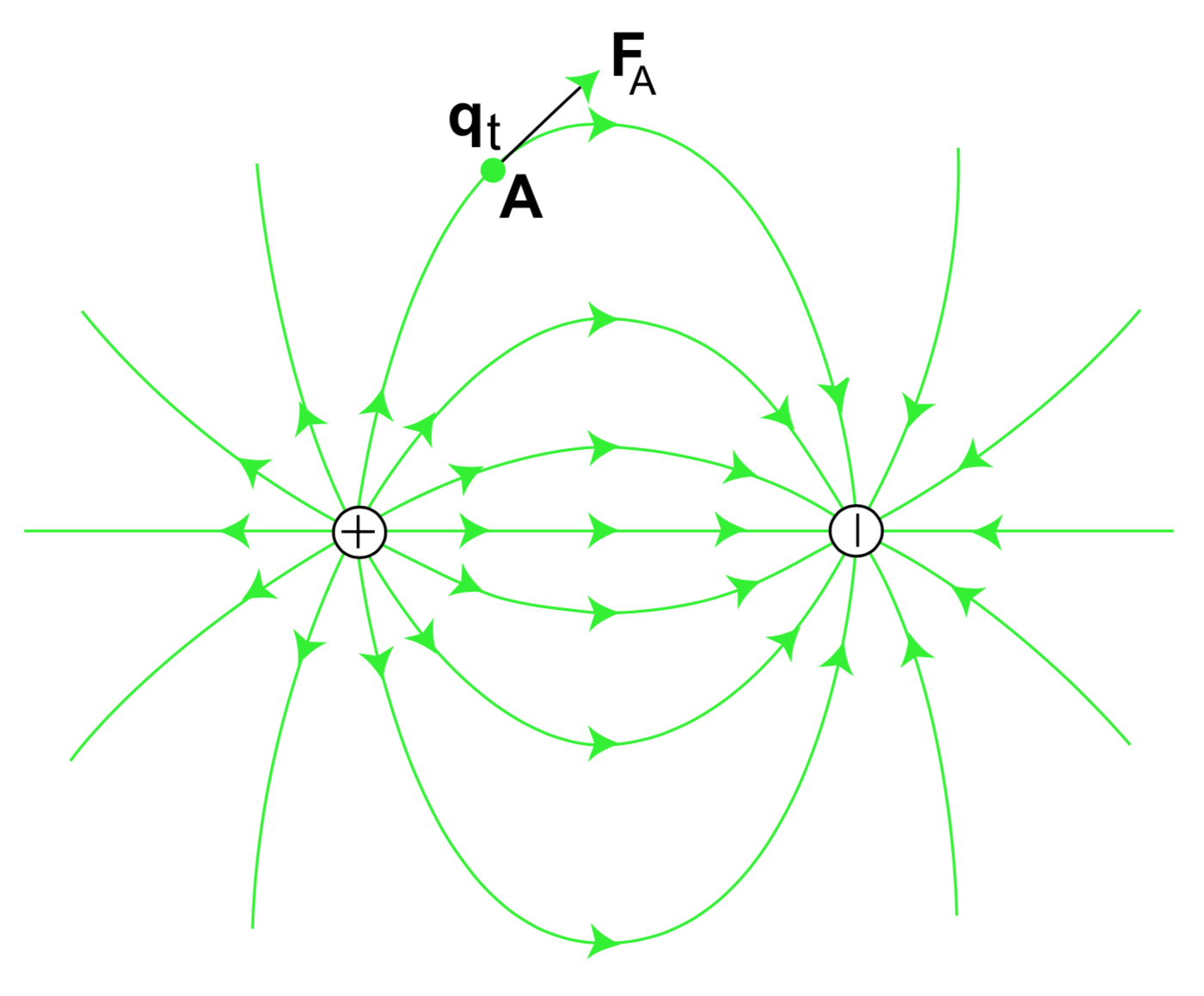
B. Magnetic Interactions
Magnetic forces are quite a bit more complicated than electric forces because they only occur between charges that are moving relative to each other. Magnetic force depends in a complicated way on the charges, their separation, and their relative motion. As in the electrical case, we say that the motion of a charge somehow alters the space surrounding it. The term magnetic field is used to describe the motion-related properties of the space surrounding a moving charge. In general, if the charge is moving faster it produces a greater magnetic field, which means that the energy stored in the field is greater and the forces exerted on other moving charges and magnets are greater. Note that the moving charges could be in a wire, in an atom, or simply moving through space. The magnetic field created by charges moving in a "circle" whose plane is perpendicular to the paper is shown in Figure 2a by drawing lines that have direction. The direction of the line indicates the direction of the field and the closeness of the adjacent lines indicates the strength of the field. If the lines are close together the magnetic field is strong.
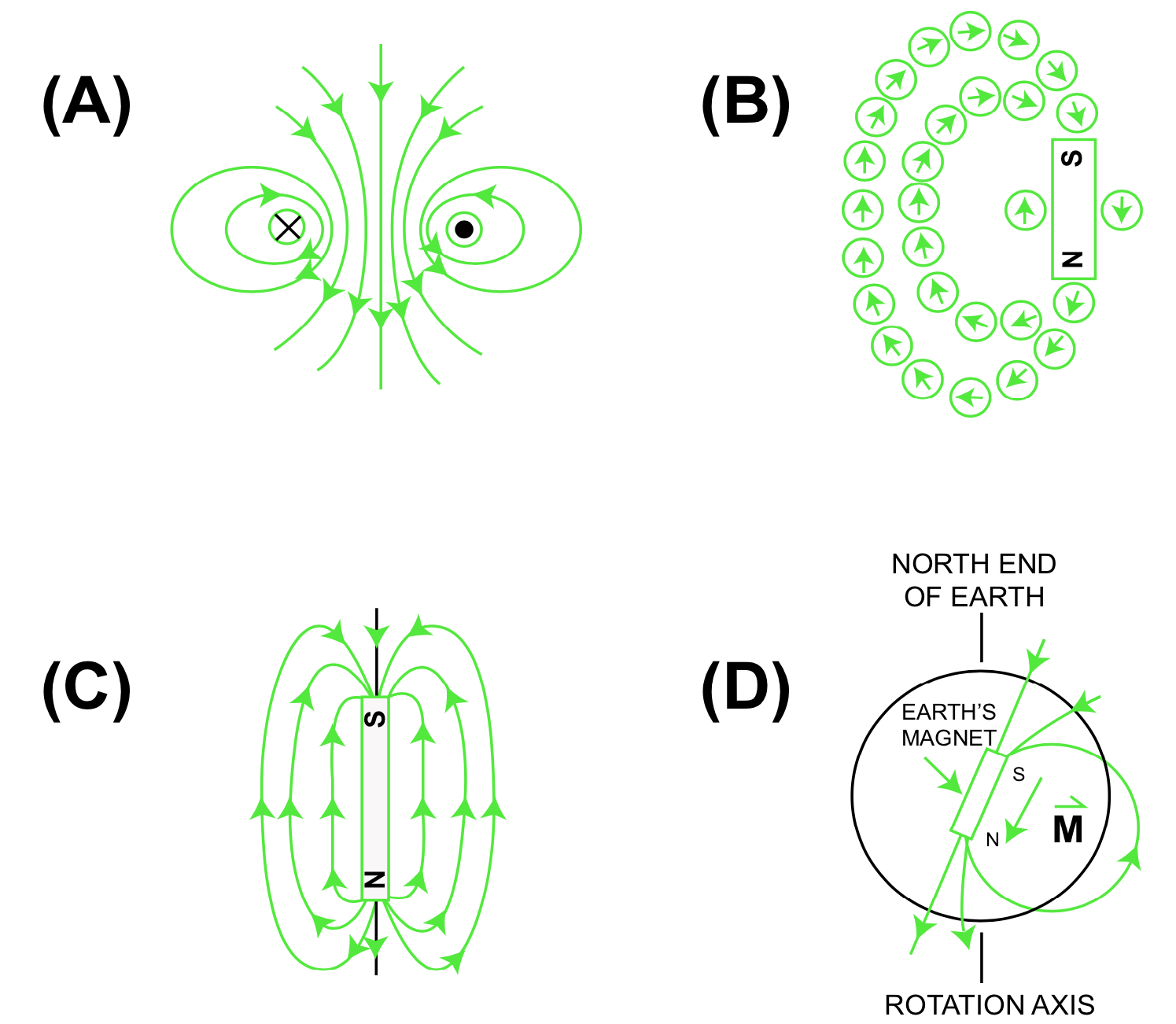
The magnetic field does not directly tell us the direction of the magnetic force on a moving charge at some point, as the electric field does. However, the magnetic field at a particular point in space does tell us the direction that a compass (which is really a small magnet) would point if placed at that location in space. One can then easily "map" the magnetic field of a bar magnet as shown in Figure 2b. Notice that the field lines go from the north pole, or end, of the bar magnet to the south pole.
The field of the earth is very similar to what one would observe if there were a bar magnet at the center of the earth, oriented as shown in Figure 2c. The type of field shown in Figure 2 is referred to as a magnetic dipole field where the di-prefix refers to the fact that there are two ends or poles on the bar magnet.
There are two ways to describe the strength of a magnetic dipole field. One is to indicate the strength of the magnet producing the field. This is called the magnetic dipole moment, or just magnetic moment and has units of gauss-cm3. The other approach is to state the value of the field itself at some point in space. The strength of the magnetic field produced between the ends of a typical child's horseshoe magnet may be a few tens or hundreds of gauss while the magnetic field produced in a research electromagnet may be as high as 100,000 gauss or 100 kilogauss. In comparison to these values, the earth's magnetic field is very small, about 0.5 gauss. For convenience, another type of unit is used when describing small fields such as the earth's. This unit is a gamma and is defined such that 1 gauss = 105 gamma. This means that the earth's magnetic field is about 50,000 gamma. The earth's field will be described carefully in a later section of this paper.
C. Magnetic Properties of Materials
All magnetic fields are produced by moving charges, but what are the moving charges in a permanent magnet such as a bar magnet or horseshoe magnet.? The atomic electrons in their motion about the nuclei of the individual atoms produce the magnetism. Why then aren't all materials magnetic since all matter is composed of atoms? There are two fundamental reasons why all matter is not magnetic: 1) The electrons must be aligned in a certain way in the atom for it to be magnetic, and 2) even if the atoms of a solid are magnetic the magnetic fields of all the atoms must be oriented so that more are aligned in one direction than in any other direction if the solid is to behave as a magnet.
Electrons move in orbits about the nucleus as well as spin about their axes like a top (very much like the earth spins on its axis as it goes around the sun). Both types of electron motions give rise to magnetic fields. The magnetic field due to the electron spin is generally larger than the field that results from the orbital motion of the electron. In most atoms the fields due to the spins of the constituent electrons cancel each other, giving no net field for the atom as a whole because there are equal numbers spinning in opposite directions. In other atoms with an odd number of electrons, the electron's spin magnetic fields are not cancelled out and as a result the atom has a net magnetic field or a permanent magnetic moment. These atoms are said to be paramagnetic.
When placed in an external field, B0, the magnetic moments of all the atoms in the material tend to line up in a uniform way that is either in the same or opposite direction with respect to the external field. Generally, when the external field is removed the moments rapidly become randomly oriented due to thermal agitation if the temperature is sufficiently high.
Some elements such as iron, nickel, cobalt, and their alloys have particularly large atomic magnetic fields or moments. These strongly paramagnetic elements are referred to as ferromagnetic. This means that when placed in an external field, the atomic magnetic moments tend to all line up in the same direction, significantly increasing the total field, perhaps by a factor of several hundred. Even when an external field is not present, the atoms in a small volume or domain will be aligned parallel to each other.
One important reason why these materials may not appear to be magnetic is that the permanent magnetic moments of the domains may be randomly oriented so that there is no net magnetic field produced by the solid as a whole as depicted in Figure 3a. When a piece of ferromagnetic material is placed in an external field, the atomic magnetic moments tend to line up with the field, as shown in Figure 3b. This means that the domains with a magnetic moment in the same direction as the external applied field actually grow larger as the others grow smaller. When iron or any ferromagnetic material is placed in a very strong external field all the domains will be lined up in the direction of the external field, thus creating a magnet.
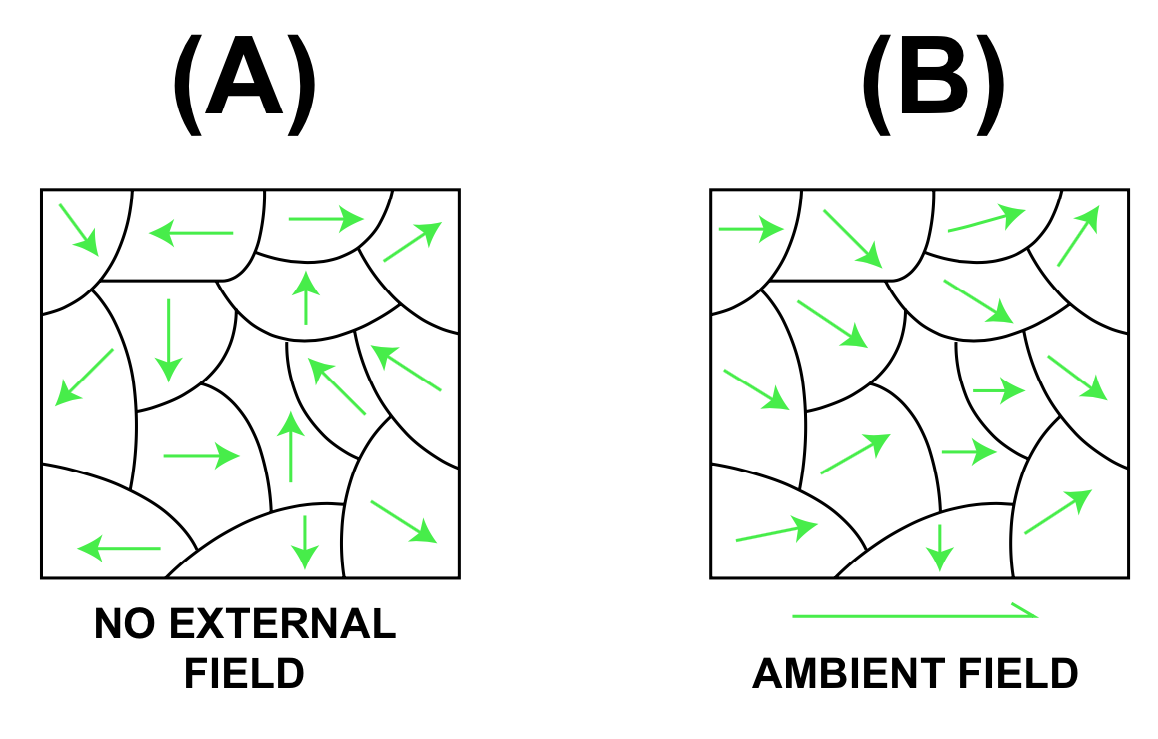
Whether the material's domains will stay aligned (the material will stay magnetized) depends on the temperature. At high temperatures, when the atoms "vibrate" vigorously, the thermal energy will be large enough to cause the alignment of the domains to be lost. Then the material behaves paramagnetically instead of ferromagnetically. The temperature at which a sample changes from ferromagnetic to paramagnetic is called the Curie Temperature and is usually between 400 and 600ºC. For pure iron, the Curie Temperature is 770ºC, while for pure nickel it is 358ºC. It should be noted that these temperatures are significantly below the melting points which are 1535ºC and 2732ºC, respectively.
It is convenient to define a magnetic property of materials called the magnetic susceptibility. The induced magnetic moment in the sample is related to the magnetic susceptibility in the following way:

For the situations we will discuss in this paper, the external field will be the magnetic field of the earth. This means that the larger the susceptibility, the larger the magnetic moment that will be induced in the sample. It is this induced magnetic moment due to the earth's field that is preserved in igneous and sedimentary rocks making them weak magnets. Figure 4 shows a graph of the relative magnetic susceptibility per cubic centimeter for several common types of rocks. It is apparent from Figure 4 that sedimentary rocks are much less magnetic than igneous effusives or plutonics. This occurs because igneous rocks, in general, contain a much higher percentage of ferromagnetic elements such as iron than do sedimentary rocks.
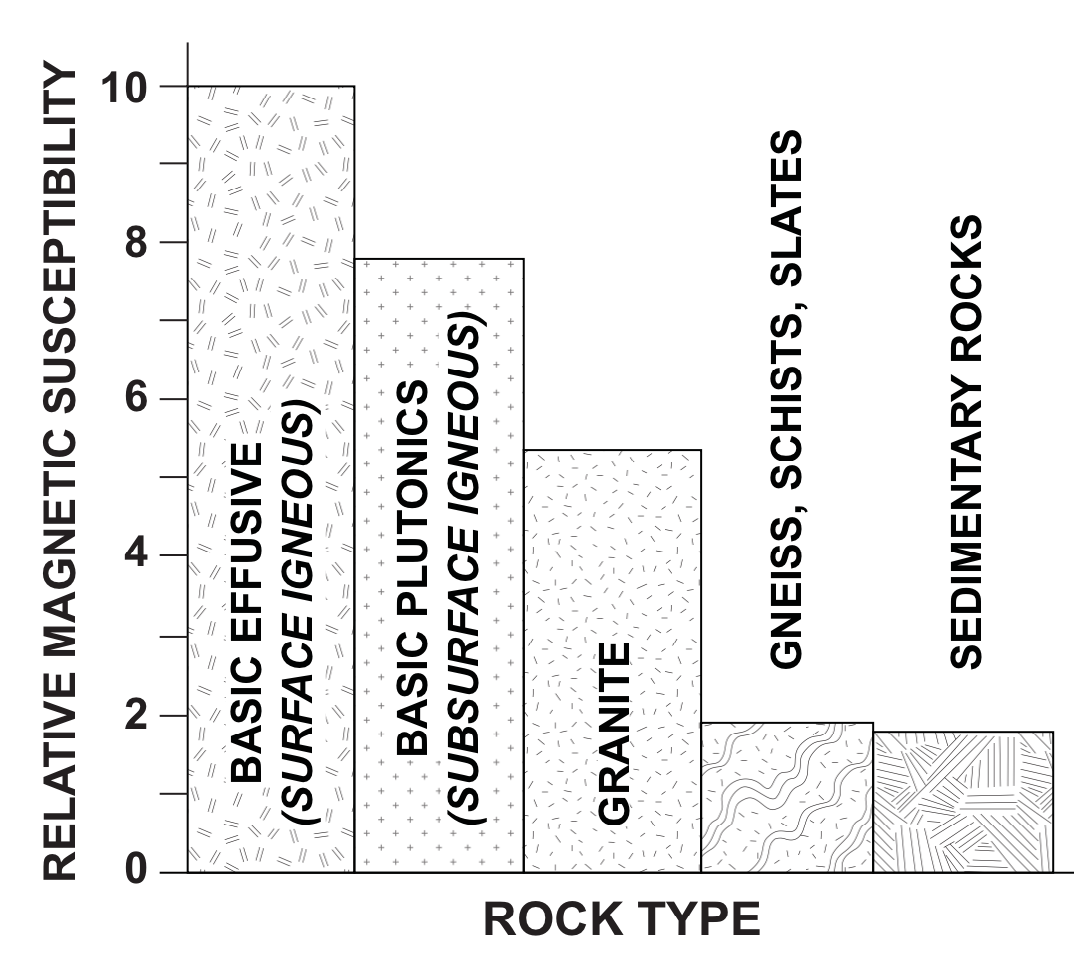
We will now proceed to describe the magnetic field of the earth and hint at how it may be produced. The discussion in Part II (to appear in the forthcoming issue of Origins) will finally put us in a position to understand how the earth's magnetic field may be produced and what the ancient or paleomagnetism "frozen" in the rocks of the earth can possibly tell us about the history of the earth.
II. THE GEOMAGNETIC FIELD
Familiarity with the overall features of the geomagnetic field (GMF) and the terms used to describe it is crucial to the understanding of paleomagnetism. Smith (1967) has made extensive review and analysis of the available data on the intensity of the ancient GMF. He points out that the present GMF may be described completely in terms of three components:
- A dipole component (like that of a bar magnet) which is the most important part of the field and which originates inside the earth.
- A smaller non-dipole component that is also of internal origin.
- A much smaller component that originates externally to the solid earth and is due to electric currents in the ionosphere.
Only the first two components are significant from a paleomagnetic point of view and consequently only brief mention will be made of the third. The two principal components will be described in terms of their spatial and temporal variations.
A. Spatial Description of GMF
In order to discuss the spatial features of the GMF it is convenient to use what is called the main geomagnetic field. The main GMF is an average field that is determined by repeatedly making measurements of the intensity and direction of the GMF at stations all over the earth's surface so that temporal variations with periods of a few years are averaged out. The main field changes slowly with time and is due to sources within the earth (Garland 1979). The general features of the main GMF of the earth can be closely approximated by the field of a magnetic dipole such as a bar magnet or current loop with its center approximately at the center of the earth. In fact, spherical harmonic analysis of the GMF has shown that about 80% of the earth's field can be attributed to a single geocentric dipole inclined at 11.5º to the earth's axis of rotation with a magnetic moment of 8×1025 gauss-cm3 (Stacey 1969). The earth's magnetic field strength varies from about 30,000 gamma (0.3 gauss) at the equator to 70,000 gamma (0.7 gauss) at the poles.
The rest of the field, commonly called the non-dipole field, exhibits roughly eight regions, extending over several thousand kilometers on the surface of the earth, where the field is either greater or less than the dipole field by about 15,000 gamma (0.15 gauss) (Tarling 1971). Careful observation of the non-dipolar part of the GMF has shown that it drifts westward by about 0.18º annually indicating that its primary source is most likely to be within the earth and below the crust (Takeuchi and Uyeda 1967). It also seems reasonable that such rapid changes would occur in a liquid core rather than a solid core. In fact, all available geophysical evidence suggests the model of a liquid outer core and a solid inner core.
In addition to these rather slow variations, or anomalies, from a dipolar field, one sees other smaller amplitude variations that occur over distances of tens or hundreds of kilometers. These are attributable to the remanent magnetization of the rocks of the crust, such as that observed above the ocean floor.
At first it might appear that the earth's magnetic field lines would be parallel to the surface of the earth since we usually use compasses that are mounted horizontally. However, this is not the case as can be seen by referring to Figure 2d or Figure 5. Figure 5 shows that, near the polar regions, the field lines point very nearly straight down into the ground or straight up out of the ground. Only near the equator does the magnetic field lie approximately parallel. This accounts for the fact that simple children's compasses will often appear to be heavier on one end than the other and thus tip down toward that end. What is actually happening is that the compass is just trying to point in the direction of the magnetic field which is at an angle to the surface of the earth.
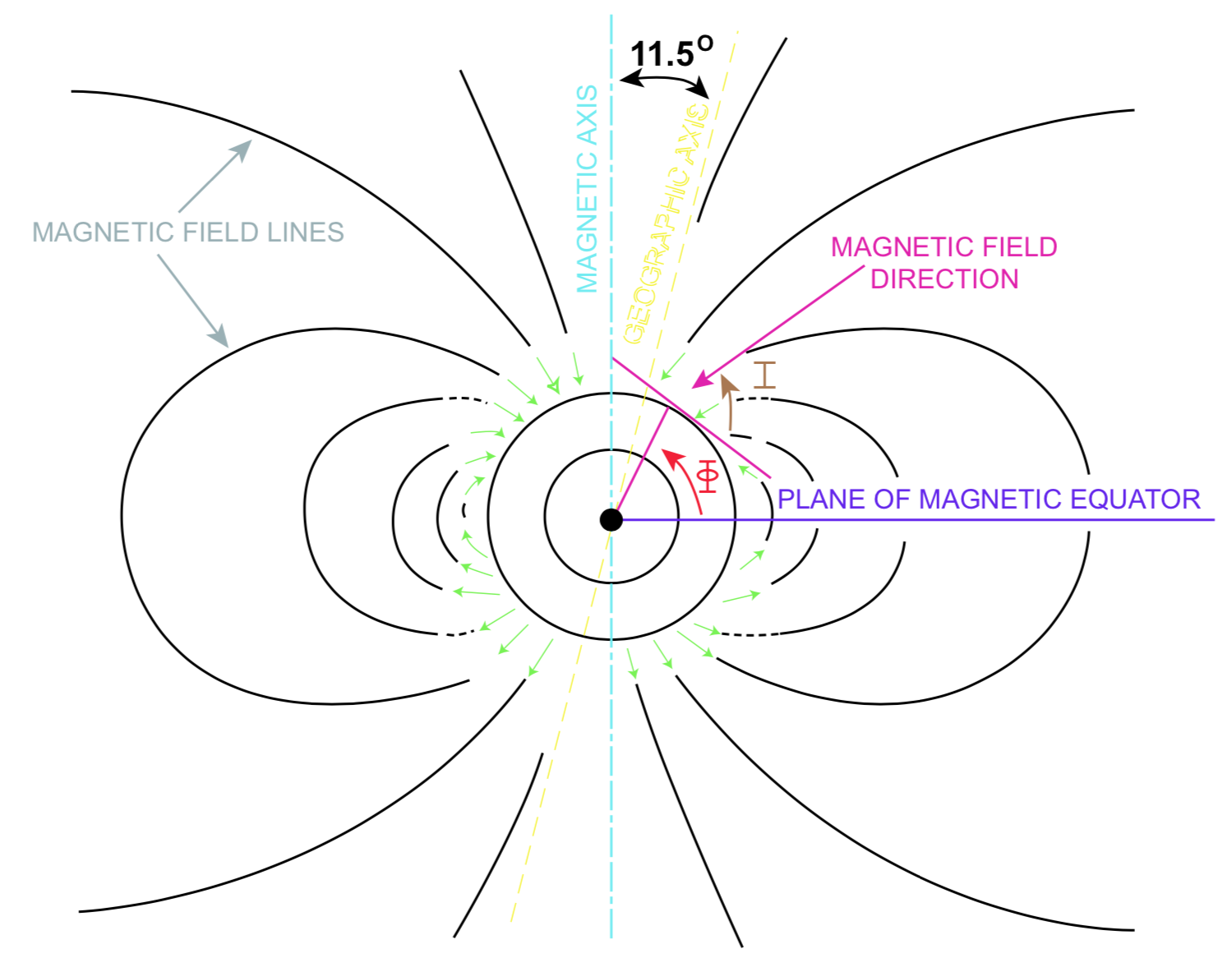
We can see that in order to describe completely the spatial variation of the GMF, one must be able to specify the direction and intensity of the field at each point on the surface. Since the GMF is approximately axially symmetric (dipolar), two numbers are needed to specify the direction and one to specify the intensity. Figure 5 shows the (dipolar) magnetic field lines for the GMF. Note that the magnetic axis through the earth is at an angle of 11.5º to the geographic or rotation axis as shown in Figure 5. For the study of paleomagnetism it is important to have a consistent system for describing the magnetic field at a specific point on the earth's surface. Consider a point at magnetic latitude, F, on the surface of earth as shown in Figure 5. The GMF at this point will have an inclination angle, I, which is measured down from the horizontal to the magnetic field line direction as shown in Figures 5 and 6. For a dipolar magnetic field, there is a straightforward mathematical relationship between the inclination angle, I and the latitude angle, F. The latitude and inclination are related by
tan I = 2 tan F (4)
If we imagine ourselves to be standing on the surface and making measurements, it is convenient to think in terms of the situation diagrammed in Figure 6. At any point on the earth the declination, D, is the angle between the direction to the geographic north pole or axis and the direction of magnetic north. The direction of the GMF at a latitude, F, is completely described by specifying the inclination and declination. To describe the intensity or strength of the GMF at a point, one must either give the value in gammas (length of the arrow) of the total field or the horizontal and vertical components of the field as indicated in Figure 6.
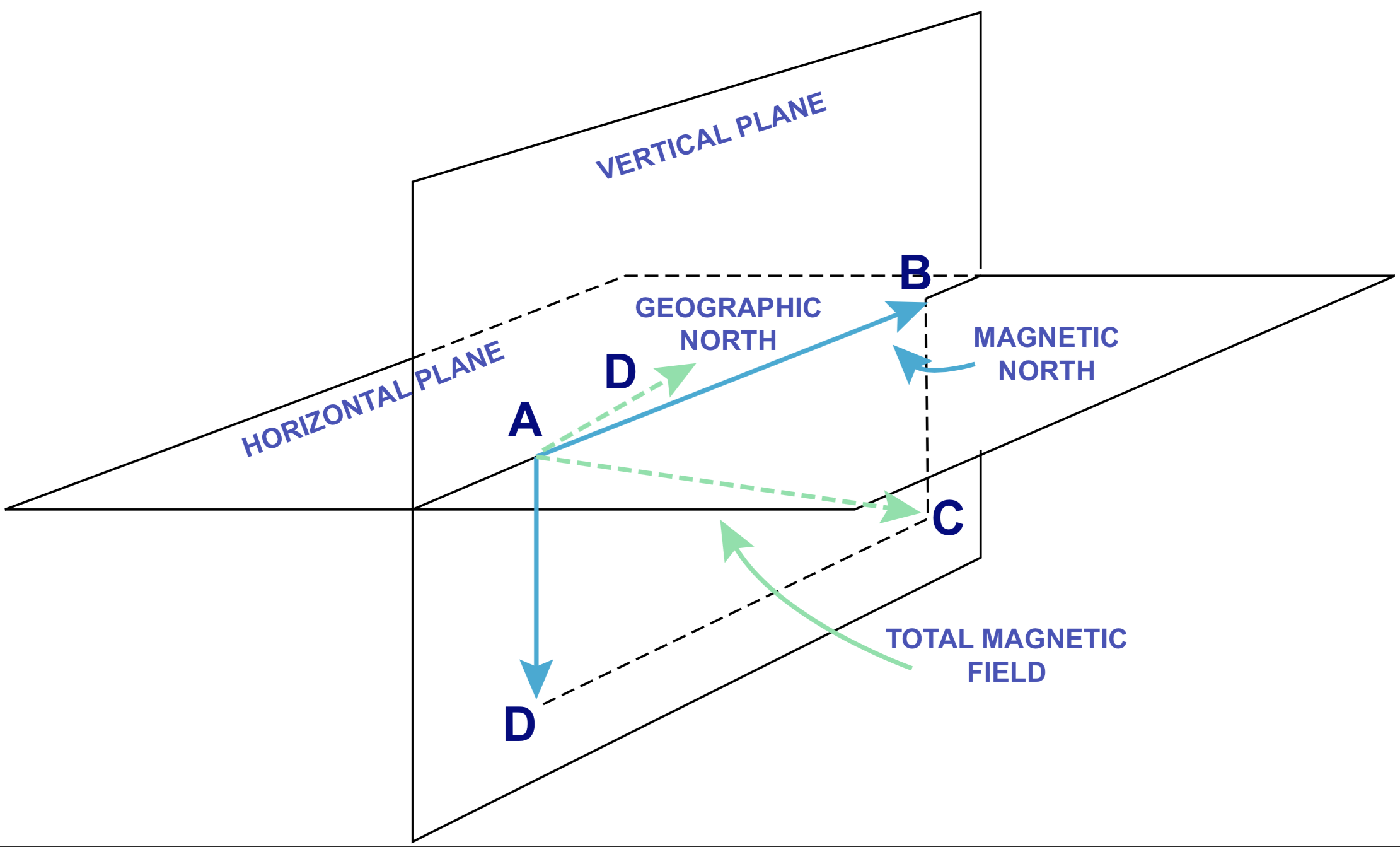
B. Temporal Variations in GMF
We commented earlier that the earth's field was not constant in time. In fact, the GMF has a wide spectrum of time variations as shown in Figure 7 from Garland (1979). The horizontal scale represents the period of the temporal change. The heights of the vertical lines give the relative magnitudes of the contribution from each of the types of magnetic field that exists. These temporal changes are due to internal and external sources of field and may be intensity and/or directional changes. The most important external sources are those labeled storms (sporadic) and diurnal (daily). Magnetic storms can cause fluctuations as high as 500 gammas or 1% of the 50,000 gamma GMF (Tarling 1971). Typical diurnal changes are 50 gammas or 0.1% of the GMF (Garland 1979, Jacobs 1963) and are caused by the effects of fast charged particles from the sun on the earth's ionosphere and thus the earth's GMF.
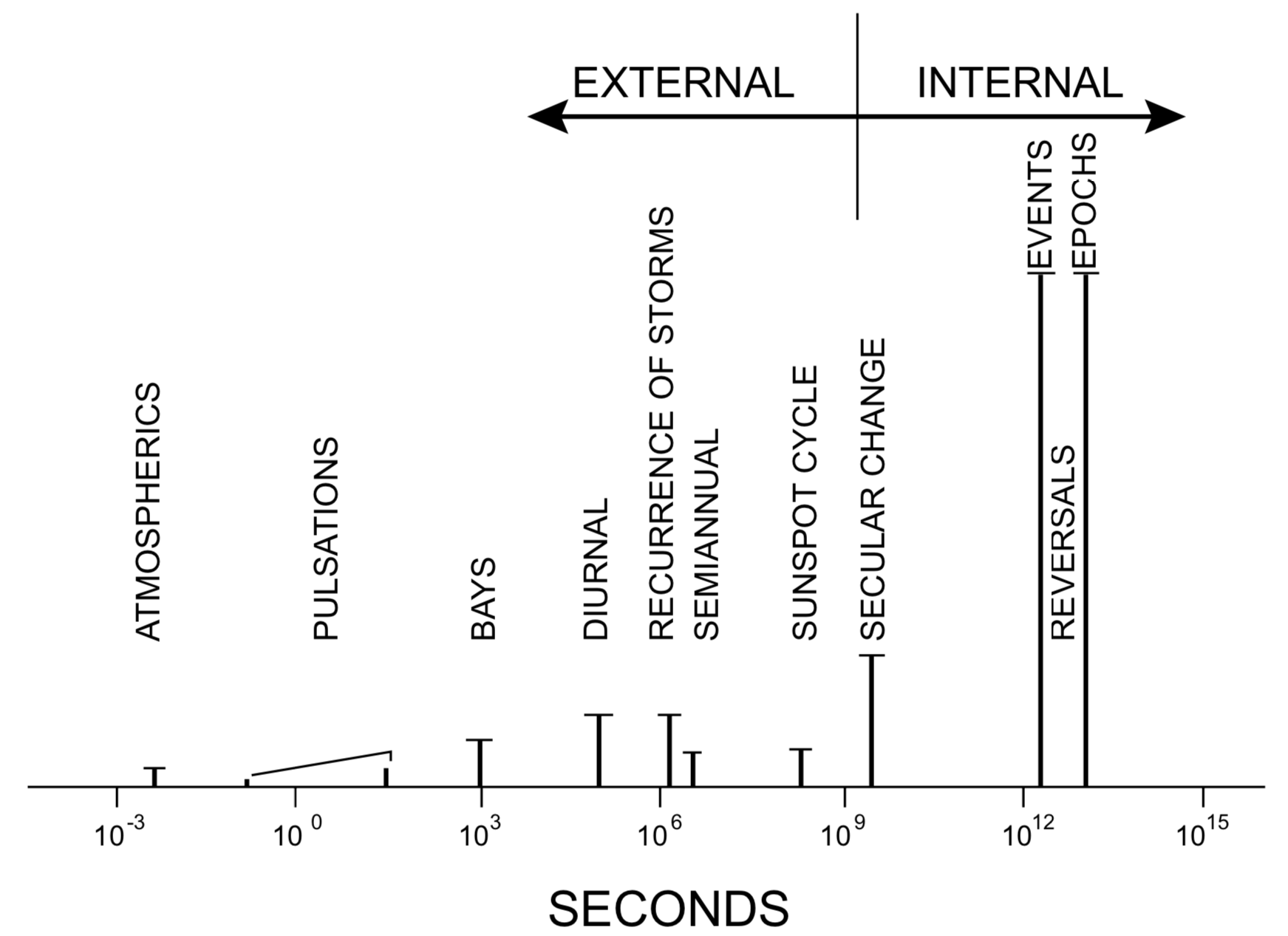
Internally caused changes in the GMF are of two types: 1) those with periods on the order of 102 to 103 years, called secular changes, and 2) reversals, which are generally, in geological terms, presumed to have periods on the order of 106 years. Both types are generally assumed to be caused by the motion of fluid in the core. Looking first at the intensity data, Figure 8, which has been extensively discussed by Smith (1967), we see that the secular variation of the intensity of the earth's magnetic field has been directly measured since about 1830 and measured paleomagnetically for samples with radiometric ages of at least 8500 years. Other references (Barnes 1971, Cox 1973, Smith 1967, Takeuchi and Uyeda 1967) also discuss the data in Figure 8.
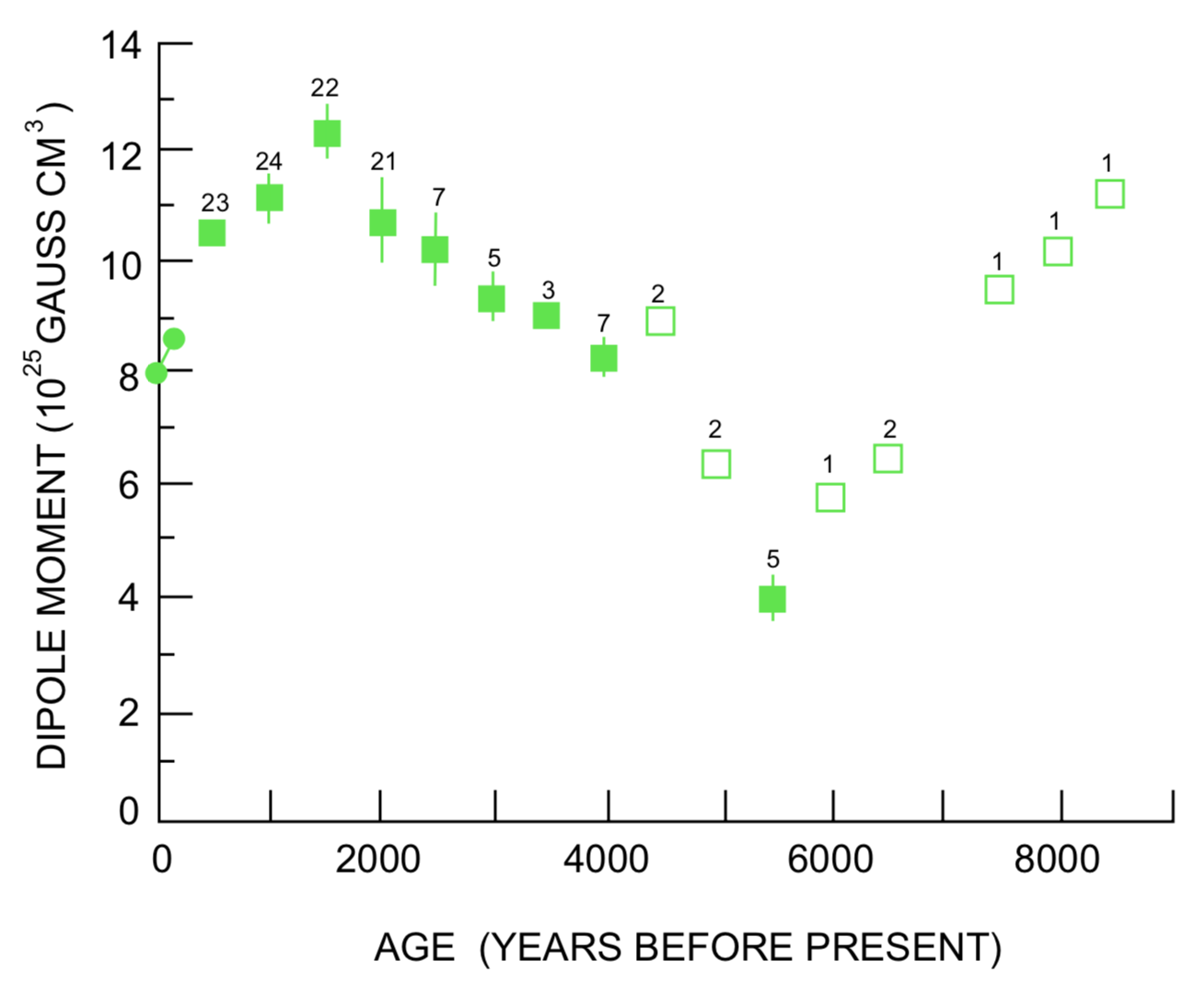
During the historical observation period of 130 years the magnetic moment decreased at a rate of about 5% per hundred years, and at this rate would disappear entirely in about 2000 years (Rees 1961). Considerable discussion centers on whether the decrease is linear (as assumed in making the 2000 year disappearance estimate) or exponential since this has implications concerning the nature of the source of field (Barnes 1971). Smith (1967), however, has shown (see Figure 8), using paleomagnetic data, that the field was probably actually increasing earlier than 2000 years ago. Part II, which will appear in the forthcoming issue of Origins, will discuss this topic further as it describes how the geomagnetic field is produced. Special attention will be given to the Barnes model (Barnes 1971) for the source of earth's magnetic field and his conclusions concerning the age of the earth based on this model.
The direction of the GMF is easier to measure and has been regularly observed in specific locations since about 1830 A.D. For example, the direction of the GMF was monitored in Paris and London for a period of about 300 years. This data along with other historic data is shown in Figure 9. Secular variations in direction and magnitude have also been observed by studying paleomagnetism in lava, pottery, bricks, and kilns (Aitken and Weaver 1965, Tarling 1971).
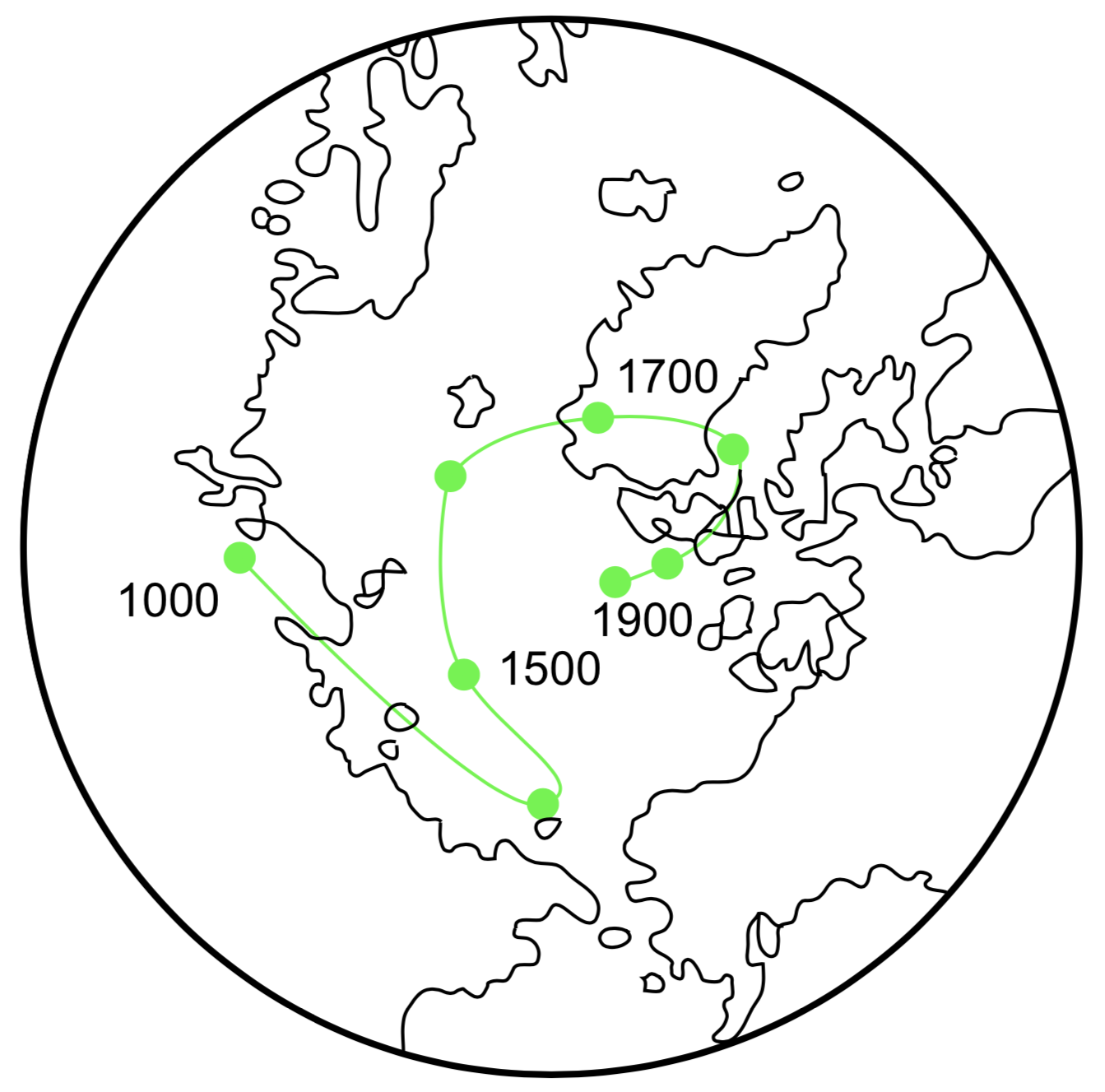
With some background in the properties of the geomagnetic field of the earth, we are now in a position to study the effects that this field can have on the magnetic materials that exist on the earth. Can these materials record a magnetic history of the earth? If so, this information may be very valuable for the creationist who tries to model a short history for the world since creation. Does the magnetic history of the earth as "frozen" in the rocks provide new information not available from radiometric dating? We will find that this is indeed the case.
III. INTRODUCTION TO PALEOMAGNETISM
The earth contains numerous elements that are generally classified as ferromagnetic. These elements can form minerals and thus rocks with strong magnetic properties. These rocks are actually rather complicated materials that can contain several types of minerals. A small proportion, 5% or less, of a typical crustal rock will be made up of iron-bearing magnetic minerals such as magnetite and hematite (Rees 1961). Below the crust/mantle boundary, or Moho, the temperature is greater than the Curie Temperature for most materials. This means that the Moho is the lower magnetic boundary for permanently magnetized materials since the magnetic directions of the magnetic domains are randomly oriented thus giving no net field if the temperature is any higher than the Curie temperature (Wasilewski, Thomas and Mahew 1979)!
This section will consider the various processes that can cause a crustal rock to be magnetized, that is, have a magnetic moment, or remanent magnetization. Processes of magnetization that occur during the initial formation of the rock, or primary magnetizations will be considered first. Most of this primary remanent magnetization takes place over a few years for igneous rocks, and over perhaps as much as several hundred years for sediments. The magnetization or magnetism that we observe in a particular rock sample, the natural remanent magnetization (NRM), is composed of whatever primary magnetization remains, as well as more recent, secondary magnetizations. These secondary magnetizations can contribute components to the natural remanent magnetization (NRM) that can give us a distorted picture of the ancient geomagnetic field. Consequently, it is particularly important to understand them as we study the magnetic history of the earth.
Rocks with natural remanent magnetism (NRM), i.e., those with ferromagnetic minerals that have "frozen in" magnetic fields, are studied for two reasons (Garland 1979). 1) The magnetic materials that produce local distortions of the earth's magnetic field are used to study structures in the crust such as ore deposits; 2) The rocks also provide information about the past history of the earth's magnetic field.
Rocks are composed of minerals, which in turn are composed of a variety of sizes of crystalline grains. Grains can have many physical shapes and may contain from one to several magnetic domains. Neel (1955), Stacey (1962, 1963), and Dunlop (1968) discuss in detail the effects of these parameters on remanent magnetism. The physics of rocks containing ferromagnetic crystalline minerals is quite complicated and much has been written on this topic. For our purposes only a brief summary will suffice, but more complete discussions are available (Garland 1979, Tarling 1971). Of these references, Tarling (1971) has the clearest description of the basic physics involved. This discussion is summarized below.
A. Primary Remanent Magnetization
When an igneous rock is formed, the hot (1000ºC) molten rock slowly cools, solidifying at around 800ºC, and then cools down to normal surrounding temperatures. Submarine lavas cool quite rapidly, but subaerial or surface deposited lavas may remain hot for several years. Intrusive, or underground, igneous rocks may take many hundreds of years to cool down. As the igneous rock, composed of a group of grains is cooled down past the Curie Temperature the group acquires a permanent magnetization in the direction of the GMF. This phenomenon is known as thermoremanent magnetization (TRM).
It should be kept in mind that the primary magnetization of any rock does not really remain constant in time but decays exponentially (viscous demagnetization). The rate at which it decays decreases as grain volume increases and increases with increasing temperature. For accurate paleomagnetic studies, then, one would ideally like large grains that have been stored at low temperatures so that the relaxation time of the primary magnetization will be long.
Sedimentary rocks can also preserve a record of the earth's past magnetic field, but since they have not been cooled from a high temperature they contain no thermoremanent magnetization (TRM). They do, however, contain grains of magnetite and hematite that have been eroded from igneous rocks possessing TRM. These fine magnetized grains behave like small magnets or compasses. As these particles of varying shapes and sizes settle out of the air or water to form a sediment, they tend to become aligned with the ambient GMF. The primary remanent magnetization that is thus acquired is called depositional or detrital remanent magnetization (DRM). As was discussed earlier, sediments are generally much less magnetic than igneous rocks, making the DRM generally about a hundred times weaker than the TRM of igneous rocks. Because of this fact, studying the remanent magnetism of sediments requires much more sensitive instruments.
There are several factors that can affect the magnetization of sediments: depositional environment, chemical reduction, disintegration, cementing processes, and compaction. The first will be discussed here since it occurs at the time of rock formation, some of the others, which occur later, will be discussed in the next section.
The depositional environment has been studied recently with respect to ash from Mount St. Helens (Steele 1981), and it was determined that the DRM of the ash which was deposited from the air accurately recorded the local geomagnetic field (GMF) in eastern Washington. However, the DRM measured for ash deposited in water in streams exhibited significant inclination and declination errors, similar to those reported in other studies (King 1955, Steele 1981, Tarling 1971). At locations where the stream's current direction was evident, the direction of the DRM was rotated toward the current direction. This makes sense, since it is generally assumed that magnetic grains are magnetized along their long axis (Tarling 1971) and it has been shown that sand grains deposited in a current have their long axes aligned in the stream direction (Rusnak 1957). It should be noted that most studies of NRM of sediments are not done on sediments deposited in streams where currents are important, but on sediments deposited in lakes and oceans where the depositional environment is quite calm. Consequently, sediments from lakes and oceans are more likely to reliably record the ancient GMF.
B. Secondary Remanent Magnetization
Secondary magnetizations are, by definition, those magnetizations that have occurred more recently than the original formation of the rock. They include viscous remanent magnetization (VRM), chemical remanent magnetization (CRM), lightning magnetization, and weathering magnetization. These can cause numerous complications in determining the primary magnetization of a rock. In addition, some materials are magnetically anisotropic, which means that they have a preferred direction of magnetization and thus may not accurately record the magnetic field direction that existed at the time of rock formation.
In the previous section, viscous demagnetization was mentioned. This means that the ferromagnetic domains in a grain are aligned by an external magnetic field but are also continually having their directions randomized by the thermal agitation. Temperature is a measure of this agitation, which means that at constant temperature in an external field, the magnetization direction gradually moves away from the original direction toward an equilibrium value along the axis of lowest energy, the easy axis, giving the sample a viscous demagnetization which is generally in the direction of the ambient geomagnetic field. To have slow relaxation rates and thus avoid significant VRM effects, one would ideally like to use samples with large grains that have been stored at temperatures below the Curie Temperature.
If the source of agitation, i.e., the temperature, of a sample is kept constant, and the particle size allowed to increase by chemical growth, a secondary magnetization can develop as the particle volume increases. This occurs because the new material will be magnetized in the current geomagnetic field direction rather than the original field direction at the time of rock formation. This effect is referred to as chemical remanent magnetization (CRM) and will be in the direction of the ambient GMF at the time the volume became larger. It may, in fact, be in a very different direction than the thermal remanent magnetization (TRM) or the detrital remanent magnetization (DRM) and can thus be a significant source of error in careful studies trying to determine the geomagnetic field direction at the time of rock formation.
Application of mechanical stress or hydrostatic pressure to ferromagnetic materials can result in pressure remanent magnetization (Tarling 1971), but the effects of pressure haven't been studied enough for firm conclusions to be drawn. However, in most rocks the effects of pressure seem to be less important than those caused by thermal effects, chemical effects and anisotropic magnetic rock properties.
Anisotropic materials are crystalline materials that have a preferred or easy direction of magnetization. The least magnetizing energy is required for a sample to be magnetized along the easy direction. If the materials responsible for the primary magnetization have anisotropic properties, then the direction of magnetization acquired by the sample may be other than parallel to the ambient geomagnetic field (GMF). When determining the direction of the ancient GMF by studying natural remanent magnetization (NRM), it is crucial, then, to establish how much anisotropy is present. There are four important types of anisotropy: crystalline, magnetostrictive, shape, and induced. For further study of these effects see Tarling (1971).
Much of the previous discussion applies to igneous rocks. It seems appropriate to also make some comments about sedimentary and metamorphic rocks. As a sediment dries out, oxidation, and reduction occur. Both of these generally lead to the formation of hematite. In addition, the sediments are continually being cemented by carbonate or silicate cements, which also contain fine hematite grains (Tarling 1971). This means that many sediments, possibly most, will acquire a chemical remanence (CRM) as these new minerals grow.
This raises an important question. Which sediments are the most reliable for paleomagnetic studies of ancient field directions? Since the processes of converting wet sediments into sedimentary rock may take considerable time, few types of sediments carry a stable remanence closely related to the actual time of deposition (Tarling 1971). For rocks that geologists classify as being greater than 100 million years old, the most reliable sediments for paleomagnetic studies are red siltstones, since they probably underwent most of their oxidation and dehydration during the first few thousand years after deposition. Varves, deep sea sediments, and any other sediments that have remained chemically stable since soon after deposition may potentially have stable primary remanent magnetization.
Metamorphic rocks have normally been subjected to pressures and temperatures that are large enough to destroy any primary remanence that may have existed. Consequently, the magnetization of metamorphic rocks is usually secondary and may be of little use except to possibly date a specific metamorphic event. Because of these problems, few paleomagnetic studies have been done on metamorphic rocks, compared to igneous and sedimentary types.
At this point it should be clear that the principal difficulties in trying to obtain and interpret paleomagnetic field direction data are knowing what the storage temperature has been, and how much the rocks have changed physically and chemically since their formation (Jacobs 1963). However, it should also be pointed out that in many situations, one can actually sort out which part of the natural remanent magnetization (NRM) is primary and which part is due to other complicating factors.
Summary and Conclusions
This paper has introduced the reader to the area of geophysics commonly referred to as geomagnetism. First we looked at fundamental ideas about electric and magnetic interactions. The concept of a "field" was introduced, a useful concept for describing any entity that has a value and a direction at every point in space.
The earth's magnetic field is primarily dipolar, which is similar to the field that would be produced by a bar magnet situated at the center of the earth. In the next paper, this information will allow us to determine the magnetic latitude and orientation of a magnetic rock at the time that it acquired a natural remanent magnetization. This type of information has been used extensively in the development of the theory of plate tectonics. The earth's field is certainly not static in time and the temporal variation of the field that is of particular interest to this discussion is that commonly referred to as "magnetic reversals."
Various types of magnetic matter have different properties when placed in an external field. Ferromagnetic materials are of most interest in studies of paleomagnetism. The term "magnetic susceptibility" was introduced to describe just how "magnetic" a particular mineral or substance is. Igneous rocks are the most magnetic and sedimentary rocks the least. However, both have sufficient magnetic minerals to be useful in studying the past history of the earth's magnetic field including both intensity variations and reversals.
This "reversal" phenomena is of fundamental importance to the study of the magnetic history of the earth and hence of interest to the creationist. Did these reversals of the earth's magnetic field, in fact, occur? If so, then what are the implications for the tectonic history and the age of the earth?
Correct determination of the direction and intensity of the ancient magnetic field is affected by the various ways a rock can become magnetized as well as the alteration of original magnetism with time. Igneous rocks are originally magnetized as they cool in the presence of the earth's magnetic field thus "freezing" in a natural remanent magnetization. Sedimentary rocks contain a few very small pieces of magnetic material. As these tiny magnets settle out of the air or water, they behave as compasses and orient themselves in the direction of the ambient earth's field, giving the rock a detrital remanent magnetization. Several processes can alter these original magnetic directions as time passes.
The goal of this paper has been to provide the reader with sufficient background information that he can, with some understanding, appreciate the applications of this fascinating area of geophysics to the study of earth history as will be presented in PALEOMAGNETISM II.
REFERENCES
- Aitken, M.J. and G.H. Weaver. 1965. Recent archeomagnetic results in England. Journal of Geomagnetism and Geoelectricity 17:391.
- Barnes, T.G. 1971. Decay of the earth's magnetic moment and the geochronological implications. Creation Research Society Quarterly 8(1):24-29.
- Cox, A. (ed). 1973. Plate tectonics and geomagnetic reversals. W.H. Freeman, San Francisco.
- Dunlop, D.J. 1968. Monodomain theory: experimental verification. Science 162:256.
- Garland, G.D. 1979. Introduction to geophysics mantle, core and crust. W.B. Saunders, Philadelphia.
- Griffiths, J.A. and R.F. King. 1965. Applied geophysics for engineers and geologists. Pergamon Press, New York.
- Hamblin, W.K. 1975. The earth's dynamic systems. Burgess Publishing Co., Minnesota.
- Jacobs, J.A. 1963. The earth's core and geomagnetism. MacMillan Co., New York.
- King, R.F. 1955. The remanent magnetism of artificially deposited sediments. Monthly Notices of the Royal Astronomical Society, Geophysics Supplement 7:115.
- Neel, L. 1955. Some theoretical aspects of rock magnetism. Advances in Physics 4:191.
- Rees, A.I. 1961. The effect of water currents on the magnetic remanence and anisotropy of susceptibility of some sediments. Geophysical Journal of the Royal Astronomical Society 5:235-251.
- Rusnak, G.A. 1957. The orientation of sand grains under conditions of "unidirectional flow": 1. Theory and experiment. Journal of Geology 65:384-409.
- Smith, P.J. 1967. The intensity of the ancient geomagnetic field: a review and analysis. Geophysical Journal of the Royal Astronomical Society 12:320-362.
- Stacey, F.D. 1962. A generalized theory of remanence covering transition from single to multi-domain grains. Philosophical Magazine 1:1887.
- Stacey, F.D. 1963. The physical theory of rock magnetism. Advances in Physics 12:46.
- Stacey, F.D. 1969. Physics of the earth. John Wiley, New York.
- Steele, W.K. 1981. Remanent magnetization of ash from the 18 May 1980 eruption of Mount Saint Helens. Geophysical Research Letters 8(4):213-216.
- Takeuchi, H.S. and H.K. Uyeda. 1967. Debate about the earth. Freeman Cooper and Co., San Francisco.
- Tarling, D.H. 1971. Principles and applications of paleomagnetism. Chapman and Hall, London.
- Young, D.A. 1982. Christianity and the age of the earth. Zondervan, Grand Rapids.
- Wasilewski, P.J., H.H. Thomas and M.A. Mayhew. 1979. The Moho as magnetic boundary. Geophysical Research Letters 6(7):541-544.